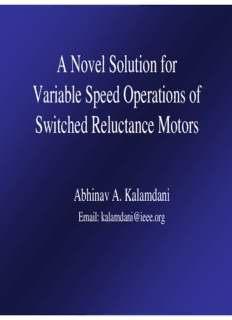Table Of ContentA Novel Solution for
Variable Speed Operations of
Switched Reluctance Motors
Abhinav A. Kalamdani
Email: [email protected]
Contents
• Introduction
• Mathematical Model
• SR Motor Drive
- Simplified C-Dump Converter
- Commutation And Direction Control
• Position Control
• Results
• Conclusions
Introduction
• SRM is an old member of the motor family, due to
electronics and complex control requirements, it did not
come into light.
• SRM has a simple and robust structure with no windings on
the rotor of the machine.
• It has high torque-to-inertia ratio and high starting torque
without the problem of in-rush currents
• Each phase winding of the SRM is independent of the other
phase windings and this makes the machine highly reliable.
Introduction (contd.)
• When the stator coils are excited the tendency of the nearest rotor pole is to
align itself with the stator attaining a minimum reluctance path for the
magnetic field, and maximum inductance.
• In the unaligned state the reluctance is maximum and the inductance is
minimum.
• The continuous excitation of the phases produces a rotating magnetic field
and the rotor rotates according to magnetic field synchronously.
Introduction (contd.)
• There are several disadvantages of SRM:
- The pulsed nature of torque production, which leads to torque
ripple and acoustic noise.
- Higher torque-volume ratio needs a small air gap between
stator and rotor, which leads to increased acoustic noise and less
manufacturing tolerances.
- The motor is not self-commutated, it needs a converter and a
commutation controller.
- The presence of high inductances increases the current rise
and decay time thus giving higher negative torques.
Mathematical Model
• The mathematical model is inconsistent over the entire
operation.
• The parameters change continuously throughout and hence
showing a great deal of non-linearity.
• However segmenting the operation regions is helpful to
analyze the motor.
• The phase voltage equation is given by:
• where V is DC bus voltage, i is the phase current, R is coil
resistance and (cid:1) is the flux linking the coil.
Mathematical Model (contd.)
• The flux linkage consists of inductance L and current i and equation (1) is
differentiated giving (2), where (cid:2) is speed and (cid:3) is rotor position.
• The inductance is continuously varying with position as shown in the figure
according to equation (3), where L is unaligned inductance.
u
Mathematical Model (contd.)
• In equation (3) the term L((cid:3)) is the instantaneous inductance at that rotor
position.
• In equation (2) the term is the slope of the inductance profile and the
term is the back-emf generated by the motoring action.
• The power equation of the motor is given by equations (4) and (5):
• The equation (5) shows the power consumed by motor. The power is lost in
resistance, inductance and the remaining energy is the mechanical output.
• The third term is equivalent to P = T.(cid:2), T is the torque and is given by:
mech
• The sign of the slope of inductance profile decides the direction of torque.
SR Motor Drive
• The SRM is not a self-commutated motor, it needs drive consisting of a
converter for delivering the power and a commutation module.
• One of the major research domains of SRM has been the converters, since
they decide the performance, efficiency, controllability and cost of the SR
drive.
• The phase independence and uni-polar current characteristic have
encouraged the development of various converter topologies.
• The drive should be able to satisfy the following requirements:
- Each phase should be able to conduct independent of other phases.
- It should demagnetize the phase before it steps into generating region.
- It should energize the next phase before the off-going phase demagnetizes.
- The demagnetization energy should be used up either by feeding it to the
source or the upcoming phase.
- The demagnetization of the phase should be very fast, to reduce the
commutation time.
- The free-wheeling facility should be provided during chopping mode.
Simplified C-Dump Converter
• The Simplified C-Dump Converter is a modified version of Sayeed Mir et.
al.’s Energy Efficient C-Dump Converter II.
Description:A Novel Solution for. Variable Speed Operations of. Switched Reluctance Motors. Abhinav A. Kalamdani. Email:
[email protected] 
